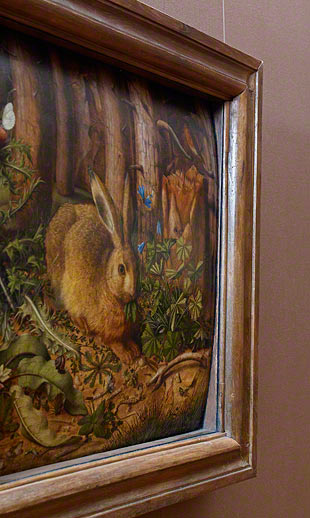
As the Getty Museum’s senior curator of paintings, I feel it is incumbent on me to walk through the galleries almost every day, speaking with the security officers and other staff and watching how the public looks at the collections. And I’ve always been curious about the kinds of questions visitors ask of the people on the front lines.

Why is Hans Hoffmann’s A Hare in the Forest curved? When wood is exposed to dry conditions, it bends or warps. Though originally flat, Hoffmann’s panel may have been exposed to heat over the course of many years, which dried it and created the distinct curved surface so evident today.
If the officers are asked the same question over and over, then we can try to answer that query in a wall label. We did this for Hans Hoffman’s Hare in the Forest, for example. The public was curious about the fact that the panel support on which the image is painted is so curved. This occasioned an additional label answering that question.
What of the questions visitors put to the staff at the information desk in the Museum Entrance Hall? Many people thought it quite amusing when I suggested that the only way to find out was by actually working behind the desk one Saturday afternoon. After I received permission from our ever-accommodating head of Visitor Services, selected a date, and prepared my travertine and white outfit, I was ready for business.
It was an exhilarating experience. Not just because of the occasional question I could actually field, but because I got to watch both the volunteers and the Museum staff deal so effectively, efficiently, and patiently with a diverse public from many different countries.
I became one of the team that day. I learned to gesture to, but not point at, the bathrooms, and to suggest meeting under the sycamores for the architecture tour or at the bench for gallery tours.
Because I’m a curator, I was relied on to answer all the “art” questions: Where is this object? Do you have a painting by so-and-so? Does the Getty have an image of such-and-such on display? However, I failed at answering questions about how to get from here to there outside the Getty (which I am not terribly good at on my own!), but I did learn how many windows there are at the Getty, what flowers were in the arrangement at the desk that day, and how to book tickets for the Villa.
The staff and volunteers couldn’t have been more accommodating to this interloper in their midst, and the four hours went by in the snap of a finger. I learned an enormous amount that day. I’d suggest that every curator take a position on the front lines for some period of time. The experience is invaluable.




Good for you! As a refugee from corporate America, who was on the front lines with visitors in a theme park, I wish that company’s management would take a page out of your book and actually do the job, especially before making decisions that impact the visitor experience!
thank you so much. Rare but important. Some museums make this one day a policy for every staff member. They mostly grumble but come back refreshed having learned a lot just like you did. Ask your colleagues to do the same, it will continue to make your museum more visitor friendly. Thanks again for doing this and then writing about it. e–
Awesome! Always a pleasure seeing Scott rack up the miles up and down the galleries.